
Powered by the popular economical 150 hp Lycoming engine, from a twin engine Piper, Marshall indicated the plane was a pleasure to do rough maneuvers like snap rolls knowing that the plane was given the right attention in the right places.
For fun aerobatics and skywriting, the Homsley Super Smoke System was installed by Marshall.
After a day‘s work, the Willie II fit all needs for relieving Marshall’s tensions. He said, "Just go up and roll, loop and spin 'til you feel free as a bird. It doesn’t take much tail wheel time to fly this little biplane with its 20 foot wing span and quick responding tail wheel. It operates with a fuel consumption of 7-8 gallons an hour".
Marshall's Willie II was equipped with dual controls and instruments and as typical of a most taildraggers was flown solo from the rear seat. With a gross weight of 1276 lbs. and an empty weight of 907 lbs., the plane was stressed for +6/-5 gs. At the time of the article Marshall’s knew of only three Willie II’s in existence. After that time, at least two more were built.
Holding a private pilot certificate and a multi-engine rating, Marshall loved the challenge of unusual attitudes and the “seat of the pants” flying. He felt this type of flying iwa about a close as a person could come to the type of fun enjoyed by those barnstormers of the early days. Marshall began flying in a Cessna 152, six years previous to acquiring this biplane. Half of Marshall’s logged time was in unusual attitudes and fun aerobatics. Having also acquired a few hours with instructors in a Pitts Special, the Marshall admitted that a lot his aerobatic experience was picked up by mistake!

In the course of researching the biplane, for an In the Loop article, this beautiful photo of N113BT was discovered. The photographer is Ron Smith, a British aeronautical engineer, author, photographer and historian. Ron confirmed the design was created by William C. Shober of Gaithersburg, Maryland.
Along with the photo were remarks by Walter van Tilborg:
""William C. Shober of Gaithersburg, Maryland, USA designed this original aerobatic design biplane, which he described as "a two-seat Pitts with a P-51 tail assembly".
Shober built and flew the first aircraft in 1970, designated Willie II and registered N7919 (c/n 1), it was powered by a 180 hp Lycoming O-360-A3A engine. The type, suited for engines in the 150 to 200 hp range, was marketed for amateur construction by Shober Aircraft Enterprises, and at least four further aircraft were completed.
Further development was halted in 1976 when the type was withdrawn from the market. The pictured N113BT was built by a Mr. Turner and fitted with a Lycoming O-360 engine. According to the FAA registery it was completed in 1975 and it received its Certificate of Authorization on June 20, 1980. By September 1992 the aircraft was in collection of the Mid-America Air Museum in Liberal, Kansas. Its registration was cancelled January 30, 2013."

Bob said, "At that time, the only two-seat biplanes were the Starduster II, and the D'Apuzzo PJ-260/Senior Aero Sport." (A derivative of the Parsons-Jocelyn PJ-260. The Parsons-Jocelyn PJ-260 was an aerobatic biplane aircraft built in the United States to participate in the 1962 World Aerobatic Championships in Budapest. The original PJ-260 was named for the pilots who commissioned the aircraft and hoped to compete with it, Lindsey Parsons and Rod Jocelyn.)
Bob's dad had a friend that built a Senior Aero Sport (Jim Frankenfield, on the cover of Sport Aviation November 1968 ) Bob thinks that project was the inspiration to build their Willie II. The father and son team made some changes including a longer main landing gear with increased tubing size. Also due to an aft CG condition a longer engine mount was built after the first weight and balance prior to the first flight. The pair also made the rear cockpit wider at the headrest station for more shoulder room.
In Bob's opinion, the Willie II design was a Pitts S-1C type structure stretched and enlarged to fit a second seat. ( Bill Shober built a Pitts S-1C prior to designing the Willie II ) The Willie II has the M-6 airfoil and 2 ailerons. The Skybolt Biplane with symmetrical airfoils and four ailerons came out shortly after the Willie II. In Bob's opinion, that is why the Willie II plans were withdrawn from the market.
As far as can be discovered, there were five Willie II biplanes built;
N7919 - the prototype built by William Shober
N113BT - built by Mr. Turner
N---- built by Richard Fox in Frederick Maryland. Mr. Fox currently owns a Piper J-3 Cub based in York, Pennsylvania with his son, Kirk Fox. Kirk owns a Skybolt and previously owned a Pitts.
N602CB - originally built by Mr. Cunningham, in 1974 in Wagner, Oklahoma, and owned and rebuilt at one time by Marshall Collins. This plane was rebuilt again a few years ago by Jeff Brass in Iowa.
N6RB - Bob's plane is pictured left below at Grimes Field, in Bethel, Pennsylvania (8N1), in 2008. The right photo shows the biplane uncovered in his family's driveway in 1975. The biplane currently has over 900 hours and is flown on weekends March through November. N6RB has been flown to EAA's Airventure, Oshkosh, Wisconsin in 1979 and to Sun n' Fun, Lakeland, Florida in the early 1980s as well as events at the Golden Age Air Museum.
Bob and his father flew together until some health problems in his dad's 60s, then Elmer became his passenger. Bob has a commercial pilot certificate, is instrument rated and is an A&P mechanic. He is currently employed by Sensenich Propeller Manufacturing Company in the Quality Assurance Department.



